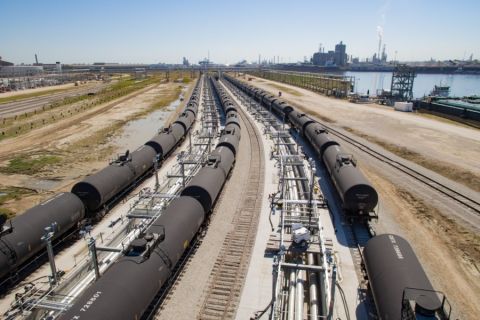Publisher’s Note: We ran into Jo Portela, co-managing director of CD Tech, at Hart’s World Refining & Fuels Conference in Washington last week. He told us there may be an announcement soon about CD Tech’s plans to use butane in a conversion process to make ETBE at what were once MTBE plants.
We thought you might want to read this story from Hart’s World Refining & Fuels Today newsletter from last year:
U.S. refiners have had some decisions to make in recent years, due to the expiration of the oxygenate requirement. Coupled with the implementation of the renewable fuel standard in the Energy Policy Act of 2005, MTBE has been virtually eliminated from the U.S. gasoline pool.
World Refining & Fuels Today found that merchant MTBE plants are now likely to convert to isooctane or isooctene production.
With no market for MTBE in the U.S., refiners could decide to use the isobutylene previously used to make MTBE for other gasoline blending components. Three such products are alkylate, a moderate-to-high octane gasoline blend stock; isooctane, a high octane (100 octane) blendstock; and isooctene, which has a slightly higher octane level than isooctane.
All three blending components have some of the same advantages as MTBE, such as low Reid Vapor Pressure.
Before the Clean Air Act of 1992 created the oxygenate requirement, isobutylene – the primary feedstock for MTBE – was used to produce alkylate. The vast majority of refineries have alkylation units, and it is expected that the elimination of MTBE means alkylation production from isobutylene will increase.
According to U.S. EPA’s Regulation of Fuels and Fuel Additives: Renewable Fuel Standard Program, released in 2006, alkylate is the most cost-effective way for refiners to reuse isobutylene, even when isooctane and isooctene’s higher octane rating is taken into account. Therefore, EPA expects that most MTBE units within or adjacent to refineries will be converted to produce alkylate, as will most ethylene cracker plants.
EPA estimates the cost of doing so at $1.42/gal.
However, for merchant MTBE plants, EPA estimates the cost of converting to alkylate to be $1.52/gal, which it believes is too expensive to justify doing so.
Isobutylene can also be reacted with itself to form isooctene, which can be blended with gasoline or hydrogenated to form isooctane. This means plants could start out producing isooctene and then move to isooctane if they determine that is what the market wants.
Alberta EnviroFuels, a joint venture between Neste Canada and Chevron based in Edmonton, Alberta, became the world’s first stand-alone isooctane facility when it was converted from MTBE to isooctane in 2002. The plant sends its isooctane to the U.S. West Coast via pipeline for gasoline blending.
In 2005, Houston-based Enterprise Products became the first U.S. merchant plant to produce isooctane when it converted its Mont Belvieu, Texas, facility from MTBE to isooctane.
Super Octanos, a joint venture plant in Venezuela set up by Venezuelan petrochemical company Pequiven and Italian petrochemical company Ecofuel, is also being converted from MTBE to isooctane. Production of isooctane was expected to begin early this year.
Valero recently converted its MTBE production at its Corpus Christi, Texas, refinery to isooctene. The refinery has an 11,500 b/d isooctene unit. The company has also installed a 2,000 b/d isooctene unit at its McKee refinery in Texas and at 13,000 b/d isooctene/alkylation unit at its Houston refinery.
Lyondell Chemical is another company that plans to convert some of its MTBE production to isooctane or isooctene, although it also plans to continue exporting MTBE internationally. — Peter Haldis
Recommended Reading
US Appeals Court Upholds FERC Approvals for Gas Pipeline Expansion
2024-05-02 - A unanimous three-judge panel of the U.S. Circuit Court of Appeals for the D.C. Circuit held that the Federal Energy Regulatory Commission was right to determine the Evangeline Pass Expansion project is functionally separate from four related gas infrastructure developments.
Enterprise Targets FID for SPOT Project by End of 2024
2024-05-01 - Enterprise Products Partners’ co-CEO disputed capex figures reported in the media regarding its Sea Port Oil Export Terminal.
US Reforms Green Law to Speed Clean Energy, Infrastructure Permits
2024-04-30 - The reforms are the second and final phase of adjustments to the National Environmental Policy Act, or NEPA, by the Biden administration.
Canadian Railway Companies Brace for Strike
2024-04-25 - A service disruption caused by a strike in May could delay freight deliveries of petrochemicals.


